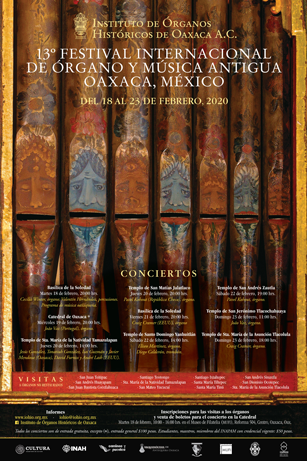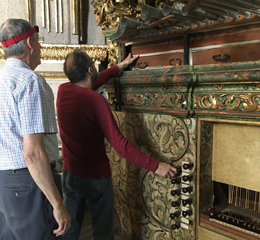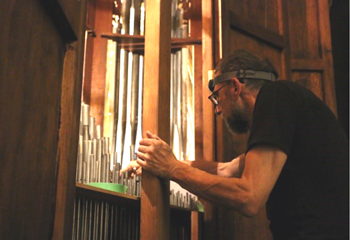 |
13th International Organ and Early Music Festival
|
In January and February 2020, the municipal and church authorities changed for a three-year period. It was necessary to visit each community to set up permission for the church visits. This had to be arranged personally, not by phone or letter, and required several all-day trips to the Mixteca Alta. |
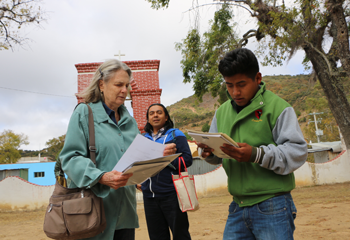 |
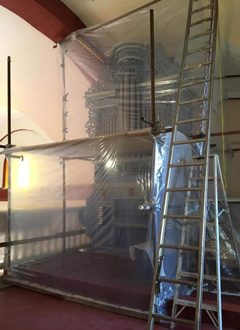 |
The Jalatlaco organ had been covered with a structure of plywood and plastic since April 2019, in anticipation of post-earthquake repair work on the church ceiling (which actually started in October). Even though the institutions in charge had promised us that the organ would be uncovered in time for the Festival, nothing happened or would have happened if the IOHIO had not offered to do the job and most importantly, to pay for it. Permission was granted and Joel Vásquez and two assistants spent 14 hours dismantling the protective structure just two days before the arrival of the Festival organists. We had already set up this concert on an alternative organ in case the Jalatlaco organ weren’t ready in time, but fortunately were able to stick to the original plan. |
CALENDAR OF ACTIVITIES
February 17 (Monday)
Portuguese organist Dr. João Vaz gave a master class in the Basílica de la Soledad to five IOHIO organists.
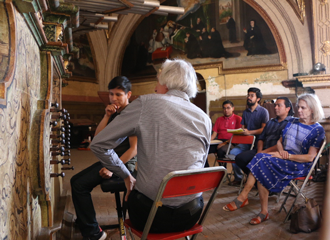
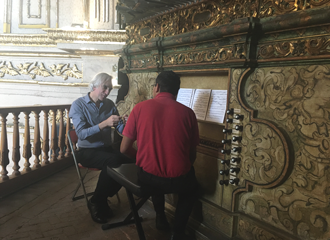
February 18 (Tuesday)
Registration took place throughout the day in the Oaxaca Philatelic Museum (MUFI). Participants had the opportunity to buy IOHIO publications and CDs, as well as books donated by the Amate Bookstore.
The Inauguration of the Festival that afternoon began with a presentation by Cicely Winter, director of the IOHIO, about the activities and goals of the Festival. Dr. Ilan Vit Suzán, Director of the INAH (Instituto Nacional de Antropología e Historia) Oaxaca, offered words of congratulations and support. The three IOHIO collaborators, Joel Vásquez, Isaí Guzmán, and Jesús González, then spoke about their ongoing projects, all outgrowths of the restored organs.
Joel Vásquez, project coordinator and organist in the Oaxaca Cathedral and the Jalatlaco church, described how the use of the pipe organ in the mass has drawn in many more worshippers. In the Cathedral this growth inspired the formation of a children’s choir which together with the organ has transformed the musical atmosphere during the Sunday mass. He also noted that people increasingly request that their private masses for baptisms, 15th birthday celebrations (quinceaños), and weddings be accompanied by the pipe organ.
Isaí Guzmán, organist in the Basilica de la Soledad and assistant organist in the church of Santo Domingo de Guzmán,, was named by the priest of the Basílica to organize the musical activities for this year 2020 in celebration of the 400th anniversary of the arrival of the statue of the Virgin Mary to Oaxaca in 1620. He also created and manages the excellent IOHIO Facebook page which now has 5000 followers.
Jesús González, organist in Tlacolula, related that he became involved with the pipe organs when the IOHIO announced free lessons for interested young people in the community after the 2014 restoration. In 2015 he began taking piano lessons in the Instituto Maurice Ravel with the support of the IOHIO and this summer will participate in a national piano competition. He presently teaches piano and solfege to beginners in the Instituto Ravel.
These three young men (dressed in black) were visible during the Festival setting up the screen and projector, hauling equipment, pulling stops, turning pages, and helping with all aspects of technical support. Andrés Aguilar, former IOHIO organ student and medical school graduate, was the physician on the field trips. They welcomed into their group Paolo Martínez, a young organist from Morelia, Michoacan, who received a scholarship to participate in the festival. |
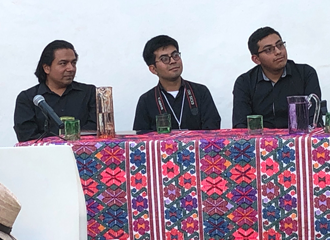 |
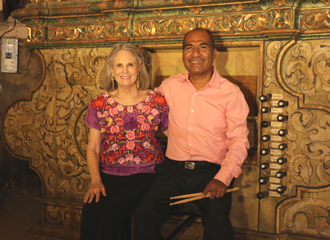 |
That evening Cicely Winter and Valentín Hernandez presented the First Concert of the Festival in the Basilica de la Soledad. Their program of Oaxaca folk music transcribed for organ and enhanced with percussion instruments always serves as an exciting introduction to the events to come, and the audience sang along exuberantly to several of the regional songs |
This concert was one of the first to celebrate the 400th jubilee year of the Virgin of la Soledad, now considered the patron saint of the City of Oaxaca. This year on the 18th day of every month she is removed from her glass case so that people may worship her up close. Since our concert took place on February 18th, the church was packed full for the mass even before the festival crowd started pouring in |
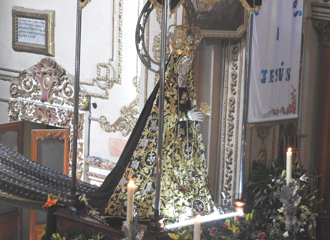 |
The magnificent decorated case of this monumental 8´ (foot) organ bears the earliest date of any Oaxaca organ: 1686. Restored in 2000, the organ is played regularly in the mass and is used for IOHIO organ lessons. This and all succeeding concerts were projected onto a screen in the church, so that the audience could have a better view of the choir loft, the artists, and the stop mechanism.
February 19 (Wednesday)
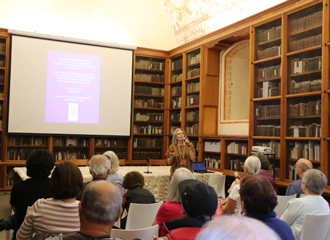 |
The day started with a bilingual presentation by Cicely Winter in the Francisco de Burgoa Library within the Santo Domingo Cultural Center about “The Historic Organs of Oaxaca and the Work of the IOHIO”, demonstrating recent advances in conservation, archive research, publications, concerts, and teaching |
Those who had signed up for the half-day tour then boarded the vans for San Juan Teitipac. Several years back, the IOHIO had discovered the organ full of candle sand flower pots in a storeroom by the church. The early 18th century organ case had been modified in the mid- 20th century to serve as a confessional. We moved it back into the church in 2008, but during a reconnaissance trip to organize the festival visit, we found that it had been returned to its former location. However, it is protected by the new authorities who recognize its value because of the IOHIO’s explanatory labels.
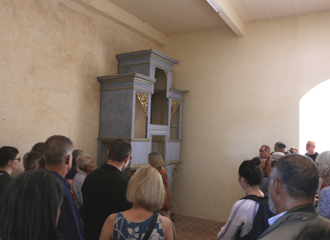
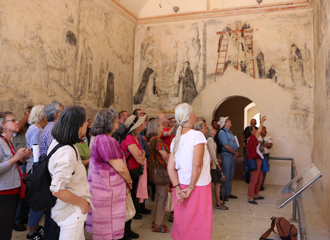
We were then treated to an explanation by Mary Jane Gagnier of the famous Dominican 16th century mural painting depicting the Crucifixion. This exquisite painting underscores the importance of Teitipac as an early missionizing base for the surrounding Zapotec area.
We passed through beautiful landscape to arrive at our next stop in San Andrés Huayapam located on the outskirts of Oaxaca City. We were received with a customary drink of tejate, traditionally served in colorful painted half gourds. A local specialty of prehispanic origin, this delicious foamy drink is made with ground cacao, corn meal, the seed of the mamey fruit, and the flower of a tree (rosita de cacao) which grows only in or near Huayapam.
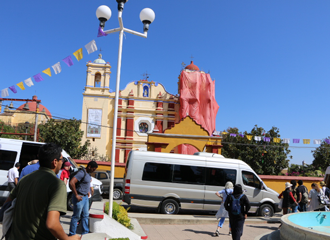
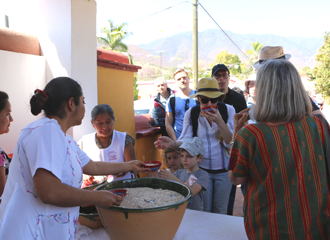
This year our visit was complicated by repair work on one of the bell towers. We had arranged permission with the INAH to enter the church, but the new municipal authorities and the church committee refused to let us in unless we paid a highly inappropriate fee. Unfortunately they had no idea about the organ or the conservation work we’ve carried out there since 2000, and the donation we offered was not enough. Fortunately the participants were settled in a nearby restaurant and took it all in stride, thanks to the delicious meal and freely flowing mezcal. After lunch the group divided so that interested organists could return to Oaxaca to play the Jalatlaco organ and appreciate its tracker action and divided registers, while the others enjoyed a visit to the famous tree in Santa María del Tule.
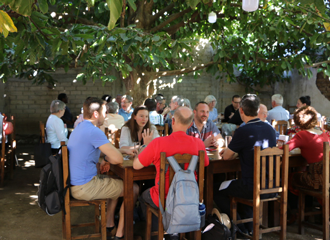
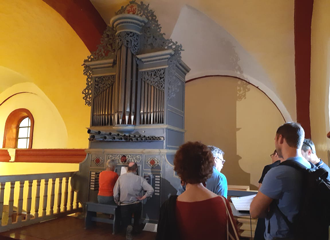
The Second Concert of the Festival was presented that night in the Oaxaca Cathedral by Dr. João Vaz (Portugal) and included the participation of the Mexican baritone Felipe Espinosa. (program) This is the only concert with a modest ($100 peso/ $5.00 USD) admission fee and Hundreds of people lined up in front of the church to buy their tickets. The proceeds support the expenses of Mexican organ students and the maintenance of the organ. |
 |
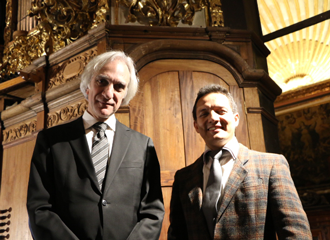
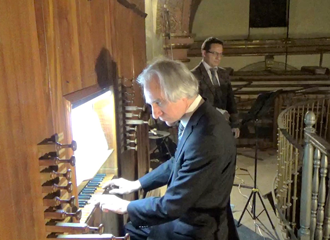
This monumental instrument was built in 1712 and reconstructed in 1996, after suffering alterations over the centuries that had completely erased its 18th century character. The contract for its construction was discovered in 2002 and indicates that it was once one of the most lavishly decorated organs in Oaxaca.
February 20 (Thursday)
 |
Our visit to the church of San Juan Bautista Coixtlahuaca had been set up with the INAH custodian Fernando Juárez who gave an excellent tour of the open chapel, the church façade, and the recently restored interior. The exquisite stone work is so well preserved that it looks as though it could have been carved yesterday. Here we saw two very different unrestored organs representing contrasting aspects of Oaxaca organbuilding over the course of 150 years. |
The 2´ table organ (ca.1720-1730) is one of the group of six in Oaxaca of similar construction and decoration. The empty case, beautifully decorated with images of saints and angel musicians, was used as a piece of furniture in the bedroom of the priest in the 1950s; a shelf was installed in the interior and a drawer placed where the chest had been. This reuse kept it in the church and probably saved it from loss.
The second 8´ organ dates from 1876 by the organbuilder José Cano and is the second-to-last documented instrument built in Oaxaca. Monumental in size with extravagant “hips,” divided registers, and opulent decoration in neo-classic style, this organ culminates the distinctive style of local organbuilding.
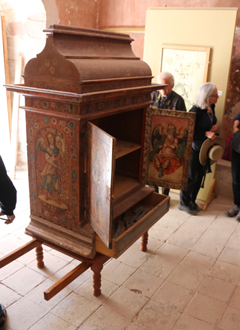
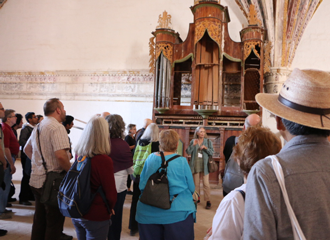
The group divided when we arrived in Tamazulapan. Most stayed in the church to admire the magnificent baroque altarpiece which includes paintings by the famous 16th-century painter Andrés de la Concha. They were also able to witness a traditional funeral mass. The rest made a quick trip to the nearby town of Santiago Teotongo. Even though all the altarpieces were draped in plastic since the church was undergoing roof repairs, the opulent organ case in a high balcony was still visible. |
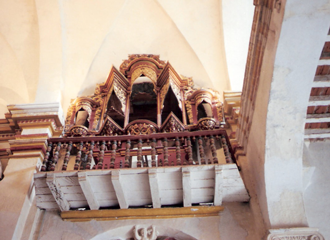 |
The Third concert of the Festival in Santa María de la Natividad Tamazulapan was a collective endeavor featuring André Lash and David Furniss (USA), and Javier Mendoza, Jesús González, Isaí Guzmán and Tonatiuh González (Oaxaca). (program) The church was full and since it was a daytime concert, groups of school children could attend. It is astonishing how the sound of this small instrument can fill the space of such a huge church.
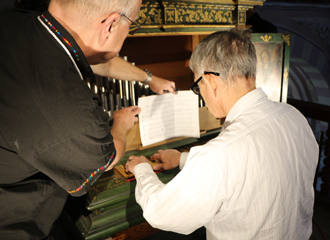
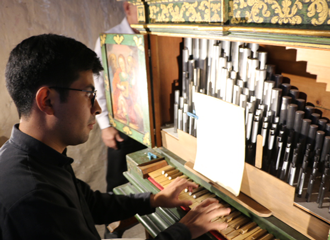
This 2´ table organ (ca.1720-1730) is situated in a high balcony and is exquisitely decorated with images of saints and angel musicians. The case and bellows are original, but the pipes, keyboard, and interior components were reconstructed in 1996. The bellows are still hand pumped, so visiting organists were invited to help out.
The second organ in this church, an imposing 8´ instrument, faces the small organ from the left balcony. Built in Oaxaca in 1840 by a member of the illustrious Martínez Bonavides family of organbuilders, it is largely intact except for the loss of nearly all its pipes; only the five largest remain in the façade. We then enjoyed a scrumptious comida (chicken with pipian green sauce) served in la Casa de la Cultura by the much appreciated Mendoza family. Upon arriving in Oaxaca, we went directly to the Jalatlaco church for the evening concert.
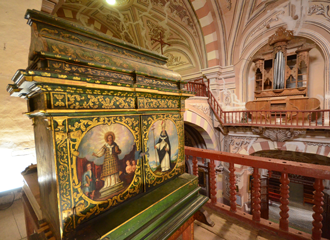
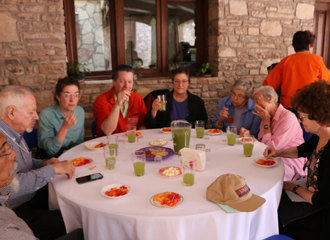
Dr. Pavel Kohout (Czech Republic) presented the Fourth concert of the Festival in San Matías Jalatlaco including organ music by Czech composers never heard before in Mexico (program) The Ambassador and Consul and their wives came from Embassy of the Czech Republic in Mexico City for the concert. This concert was the first big event involving the organ after the roof restoration, and the audience spilled out into the atrium all around the church.
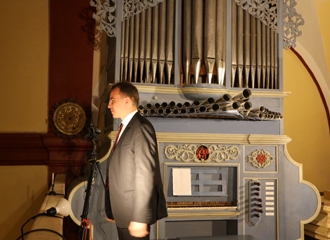
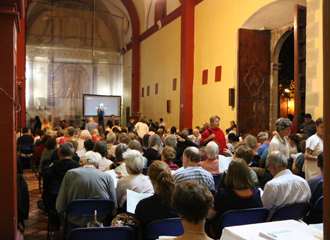
Restored by the Gerhard Grenzing Company in 2016, this elegantly proportioned 8´ organ was built by the Oaxaca organbuilder Pedro Nibra in 1866 and is one of the last to be built locally. It has a 56 note chromatic keyboard, pitch of a=396 Hz (surprising for a 19th century organ), and “almost equal” temperament. In contrast, all the other organs heard during the Festival date from the 18th century and have or had a 45 note keyboard, a short octave, and meantone temperament. Note: two other pipe organs in the state of Oaxaca with later dates were repaired and are playable, but they were built in the state of Puebla and represent a different organbuilding tradition.
February 21 (Friday)
Thirty organ aficionados weathered the three hour trip, two of them on an unpaved road, to the remote community of Santiago Ixtaltepec high up in the Mixteca Alta (altitude: 2260 meters/ 7415 feet). Once we finally reached the town and the door was flung open to their little “Musical Instrument Museum,” you could hear a gasp as participants were confronted with yet another beautifully decorated 2’ table organ. A paper label affixed to the interior of the case notes the construction date of 1730. Some years back the IOHIO collaborated with the community in consolidating their instruments and colonial art into a room next to the church, with the organ as the main showpiece.
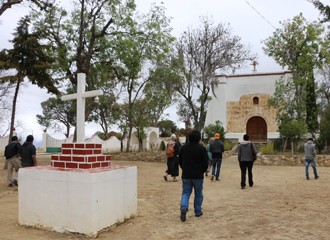
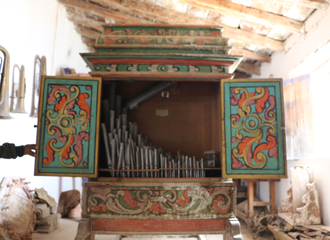
This organ is the only one of its category with pipes, keyboard, and interior components, although they are not all original. The organ was intervened in 1872 as noted by an inscription in the interior of the case, and it appears that many parts were replaced, although in their original style. Interestingly enough, the figures depicted on the sides and doors are Jesuit rather than Dominican. Since Ixtaltepec is in Dominican territory, one wonders if the organ might have been purchased from another community, since it appears that organs were moved around more often than previously imagined.
An early 19th century fortepiano of simple artisanal manufacture sits on a table and was presumably used as a practice instrument. A variety of 19th century band instruments is also on display.
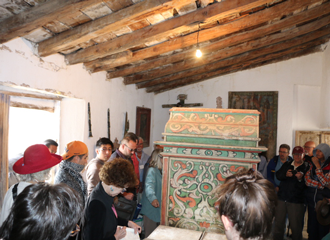
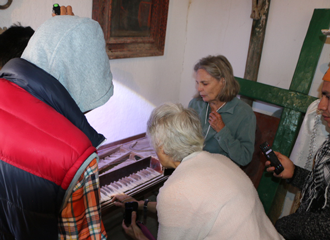
The women of the town offered us local specialties to warm us up: squash soup cooked with wheat grains (trigo con calabaza) and rabbit ribs in barbecue sauce served on tortillas, a new and unexpected culinary experience for all. The town also boasts an outstanding collection of fossils which were displayed in a separate room, the “Fossil Museum,”
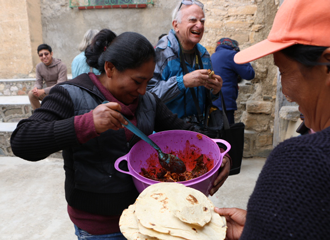
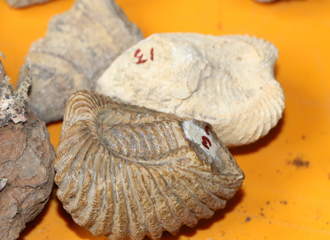
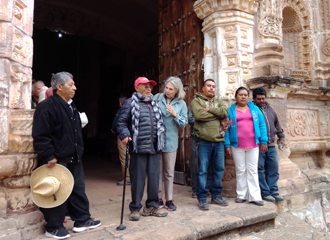 |
We then proceeded to the more accessible Mixtec town of Santa María Tiltepec. Located in the Dominican sphere of Yanhuitlan and built atop a prehispanic temple, this 16th century church has long been appreciated by art historians for its richly carved asymmetrical façade and stone interior arches. The unrestored 4´ organ is one of Oaxaca’s oldest (1703) and is always astonishing when viewed for the first time. Unfortunately nothing is known about its history to explain its idiosyncrasies of construction and decoration, and if it didn’t have the characteristic Oaxaca hips on the sides of the case, one might wonder if it were imported. |
Our visit was enhanced by the presence of 90-year-old Don Arnulfo Cruz, our contact in the village since 2000 when he was the custodian of the church. He related incidents from the time of the Revolution when soldiers were quartered in the church and burned at least one splendid baroque altarpiece for firewood.
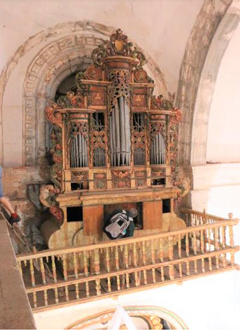
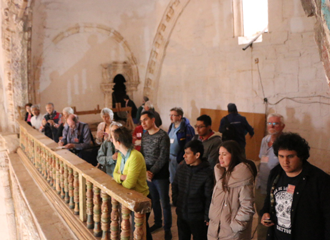
We arrived in Oaxaca City in time for the Fifth Concert of the Festival presented by Dr. Craig Cramer (USA) in the Basílica de la Soledad. (program)
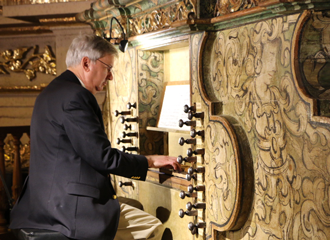
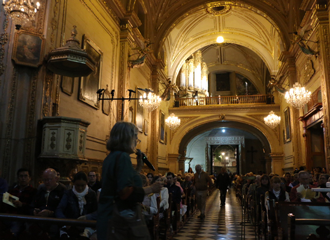
February 22 (Saturday)
This year more than 100 people participated in our popular all-day excursion to the Mixteca Alta. We crossed a dry river bed to arrive in Santa María Tinú (population ca. 150), where we were greeted by the authorities, with their canes of office (bastones de mando) in hand, at the entrance of the little stone church. Here the Mixtec women used to weave hats, baskets, and sleeping mats with palm, but now palm has given way to colorful raffia, and what a sight greeted us! Multicolored woven products were lined up atop the walls of the atrium and spread out on tables around the periphery, adding to the festive welcome on this beautiful day.
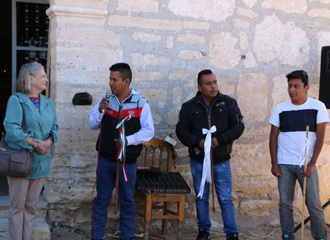

The Tinú church houses a disproportionately large organ. The date of construction, 1828, and the name of the organ builder, Marcial Silvestre Velásquez, are written inside the case….such luck! Perhaps the organ was originally commissioned for a larger church, then sold to Tinú, or the community simply wanted something grand. The organ, completely intact and played in the 1970s, still sounds when one of the three bellows located in the loft above is pumped. Unfortunately because of the reduced population and remote location of the town, a restoration would be impractical, but the people understand the importance of conserving the organ, because you never know what might happen in the future
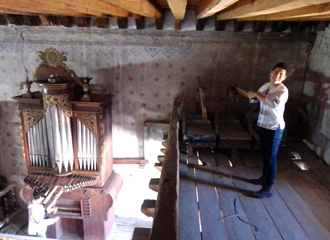
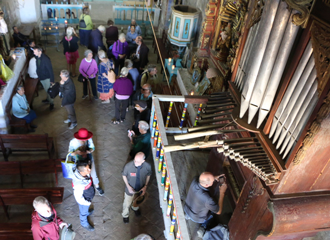
The next stop was in the lovely baroque church of San Mateo Yucucuí, situated on a promontory overlooking the Yanhuitlán Valley (population ca. 160). This organ built in 1743 is richly carved and largely intact; it is also the least altered of all the 8´ 18th century Oaxaca organs. When last played (1930s?), When it was last played around the mid-20th century, it is said that its sound could be heard for miles around. This instrument was never painted or gilded, probably not by choice during that opulent baroque era, but rather because of the cost. The floor of the high balcony on which the organ sits is much deteriorated and access to the façade is dangerous, so our efforts to clean and document the organ have been restricted.
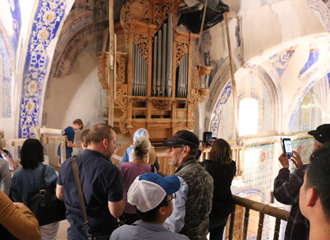
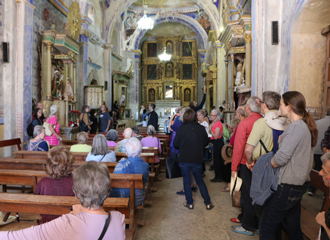
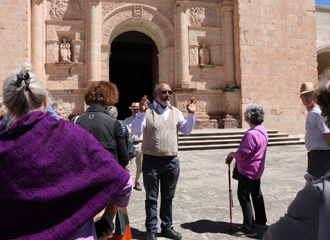 |
We proceeded to Santo Domingo Yanhuitlán where our guide Juan Montes gave a tour of the church exterior and interior before the concert. This 16th century Dominican stronghold for the Mixteca Alta region exhibits a soaring stone vault supported by lateral flying buttresses and magnificent altarpieces and is considered one of Mexico’s most majestic complexes of baroque art. |
The Sixth Concert of the Festival was presented by Oaxaca musicians Eliseo Martínez, organ, Diego Calderón, trombone, and Sócrates Juárez, violin. (program) This magnificent organ was built around 1690-1700 and restored in France in 1998. Its case is one of the most elaborately decorated of all Mexican organs, with Dominican symbols and fantastic swirling imagery, similar to that of La Soledad, as well as fierce faces painted on the façade pipes.
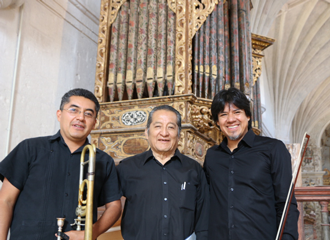
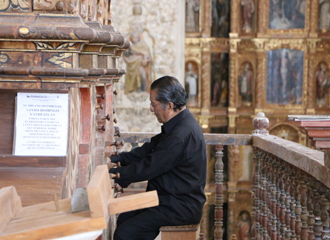
The day culminated with the traditional pre-concert fiesta in San Andrés Zautla. We were received in the atrium of the church by the local band with fireworks, plenty of mezcal, necklaces of bugambilia, and dancing. We then proceeded to the municipal library across the street from the church to savor a delicious meal of estofado de pollo (chicken stewed in almond sauce), organized by our friend and fiesta coordinator Lídia López. The dancing continued until concert time when we crowded into the church where many people from the community were already waiting for the Seventh Concert of the Festival, presented by Pavel Kohout. (program)
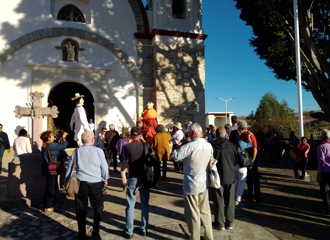 |
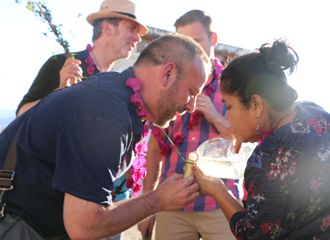 |
||||
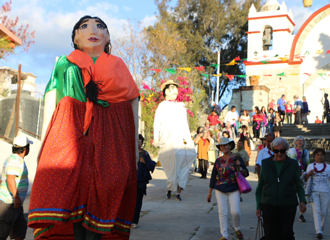 |
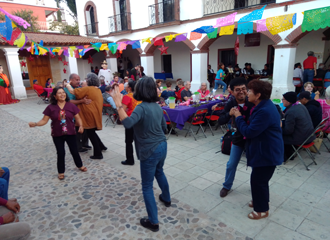 |
We were honored to have with us José Miguel Quintana from Mexico City whose association “Órganos Históricos de México” had financed the restoration by Susan Tattershall of the organs in Zautla, the Oaxaca Cathedral, and Tamazulapan in 1996.
A canine member of the audience demonstrated musical sensitivity and polite concert behavior.


The case of this 4´ table organ (1726) is exquisitely carved and gilded and painted with images of saints and archangels. The registers of table organs are controlled by tabs protruding from the sides of the case and thanks to the screen projection, the audience could appreciate the technique.
Thanks to the ongoing support of the Federal Road and Bridge Commission (CAPUFE), an entrance was opened from the super highway, allowing us direct access to and from Zautla. |
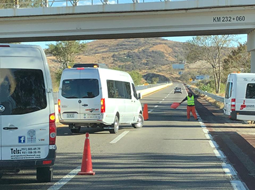 |
February 23 (Sunday)
The next morning João Vaz presented the Eighth Concert of the Festival in San Jerónimo Tlacochahuaya (program) In February 2017 the organ was cleaned, tuned, and voiced by an expert from the Grenzing Company months before the September earthquake, during which the pipes were jiggled around but fortunately easily repositioned.
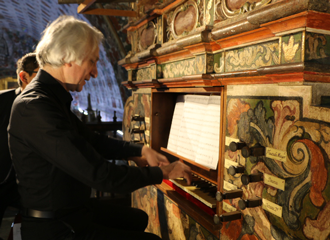
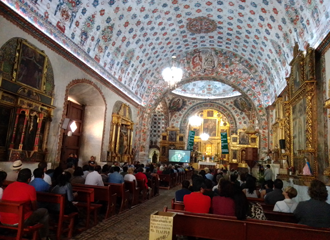
The church is one of the loveliest in Mexico with its exuberant interior floral decoration and splendid baroque altarpieces, all restored in the past 20 years and explained by our guide Juan Montes. The 4´ organ was built sometime before 1735 and restored in 1991 by Susan Tattershall. Floral motifs adorn the case and pipes, and the organ harmonizes beautifully, both visually and acoustically, with the architecture of the church.
After a buffet luncheon in Mitla, we continued on to San Dionisio Ocotepec. Here we saw one of the earliest dated organs, 1721 written on a paper label inside the case, as well as another label referring to a repair in 1842 by a member of the Martinez Bonavides organ dynasty. Most unusual are the painted images on the doors of the organ (now detached, framed, and hanging in the sacristy): Santa Cecilia playing the same Ocotepec organ and King David playing the harp, both religious figures associated with music.

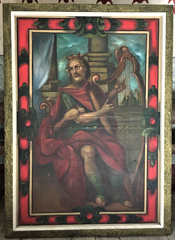

In Tlacolula, participants could admire two organs in the choir loft: the large restored organ as well as the little 2’ organ which appears to date from around 1700 as indicated by the style of its remaining painted decoration. Originally located in the choir loft of the baroque side chapel, it is the smallest Oaxaca organ with only two registers. Those who needed a break from churches could roam around one of the most famous indigenous markets in Oaxaca and admire the women’s costumes and the stalls piled high with local produce
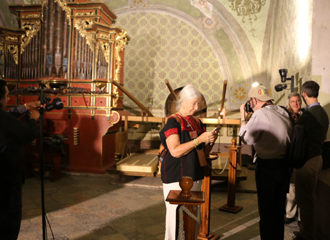
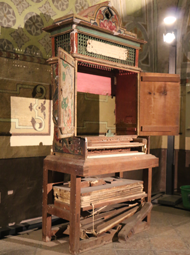
The Ninth Concert of the Festival was presented in Santa María de la Asunción Tlacolula by Craig Cramer. (program). Built in Oaxaca in 1792 by Manuel Neri y Carmona, the organ was restored by the Grenzing Company and inaugurated during the Tenth IOHIO Festival in 2014. The baroque style case is painted red and black and opulently gilded, and it has the most elaborately painted façade pipes of any Mexican organ. Local people began to arrive for the mass following the concert, so by the end the church was full. It’s likely that many were hearing and viewing the organ (on the screen) for the first time and must have been amazed by what they heard coming from their own church.
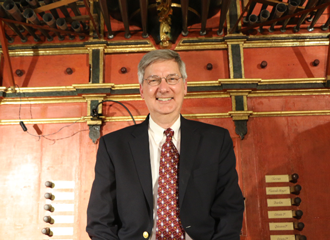
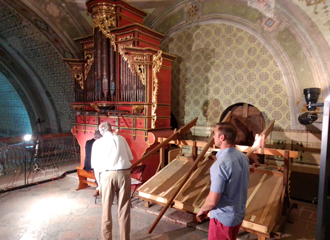
After the concert the remaining participants, around 60 people, sat down to a final meal of Oaxaca cuisine in the patio next to the church. The marimba ensemble played regional music, enhanced by the mellow crooning of the parish priest, padre Salvador Cruz.
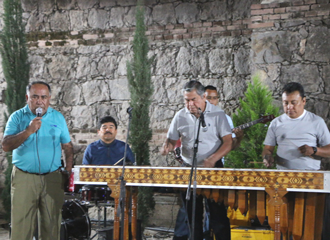
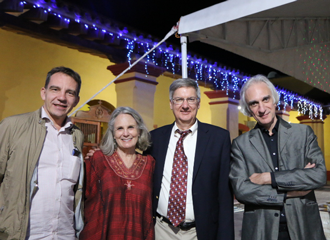
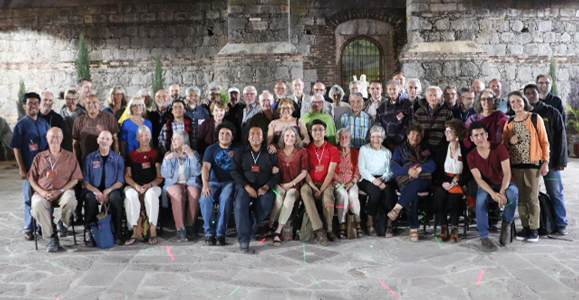
February 24 (Monday)
Around 30 people made the trek up to the archeological site of Monte Albán to enjoy a guided three hour tour with Dr. Marcus Winter from the Oaxaca INAH.
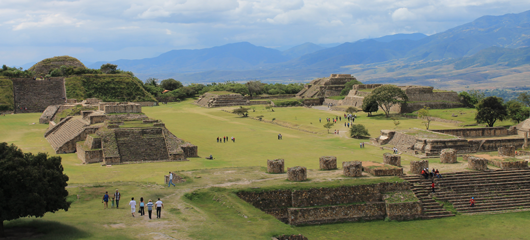
Supporting institutions
We are most grateful to the following institutions and businesses for their ongoing support of the IOHIO Festivals:
SECULTA/INAH Oaxaca
Arquidiócesis de Antequera Oaxaca
Caminos y Puentes Federales (CAPUFE)
Museo de Filatelia de Oaxaca (MUFI)
Biblioteca Francisco J. de Burgoa
Hotel Parador San Agustín
Hostal de la Noria
Hotel de la Parra
Amate Books
Carteles Editores
Oaxaca Eats
Oaxaca Eats
